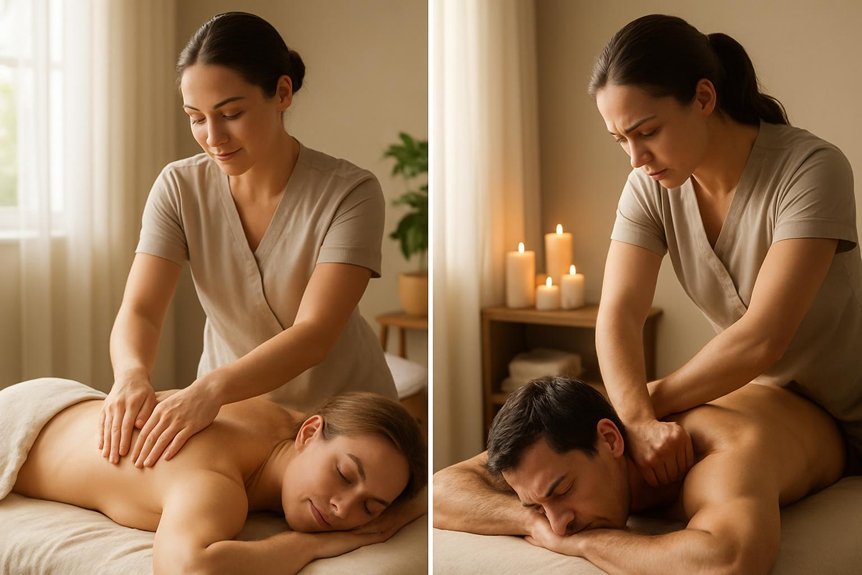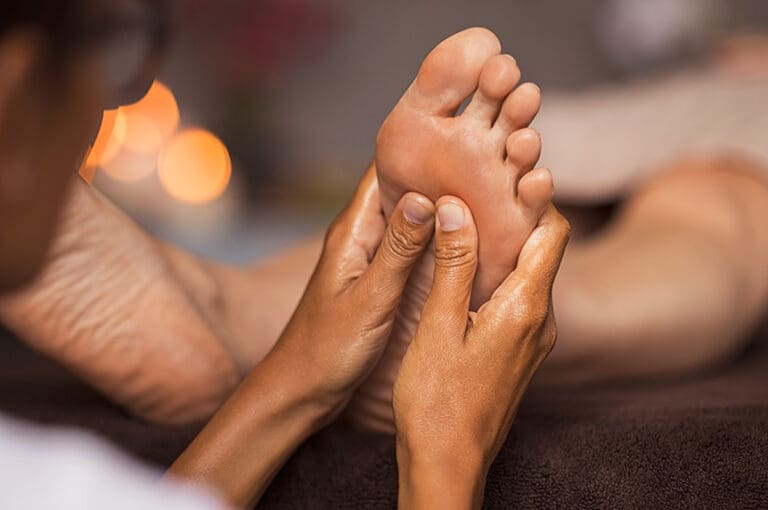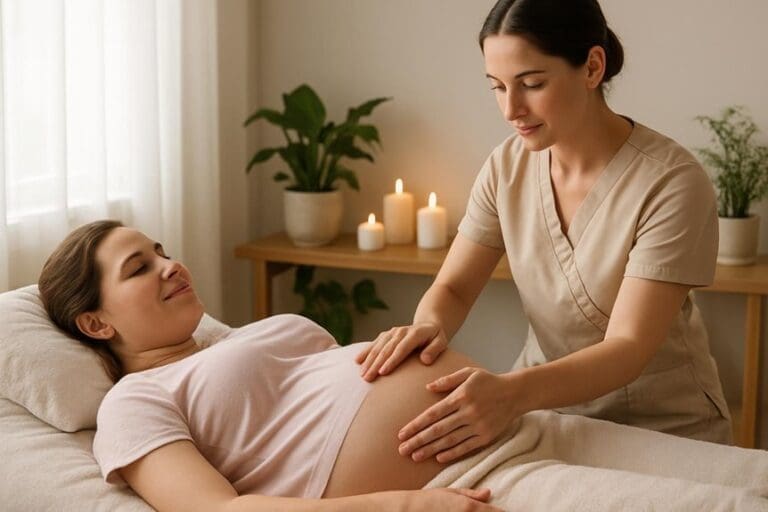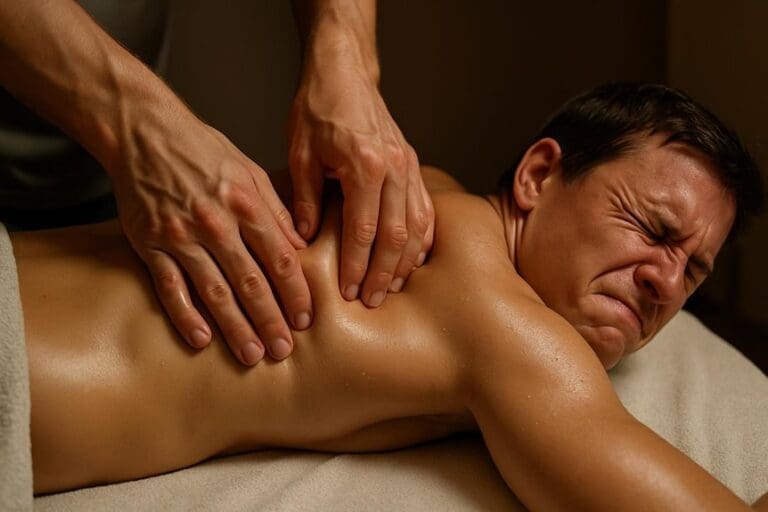Swedish massage employs gentle, flowing strokes and moderate pressure to enhance relaxation, circulation, and general well-being, targeting superficial muscle layers. In contrast, deep muscle therapy utilizes slow, focused techniques and greater pressure to access deeper musculature and fascia, addressing chronic tension and myofascial adhesions. Each approach is selected based on therapeutic objectives and individual client needs. Further details can clarify the ideal applications, session experiences, and recommended aftercare for both modalities.
Understanding the Techniques: Swedish vs. Deep Tissue Massage
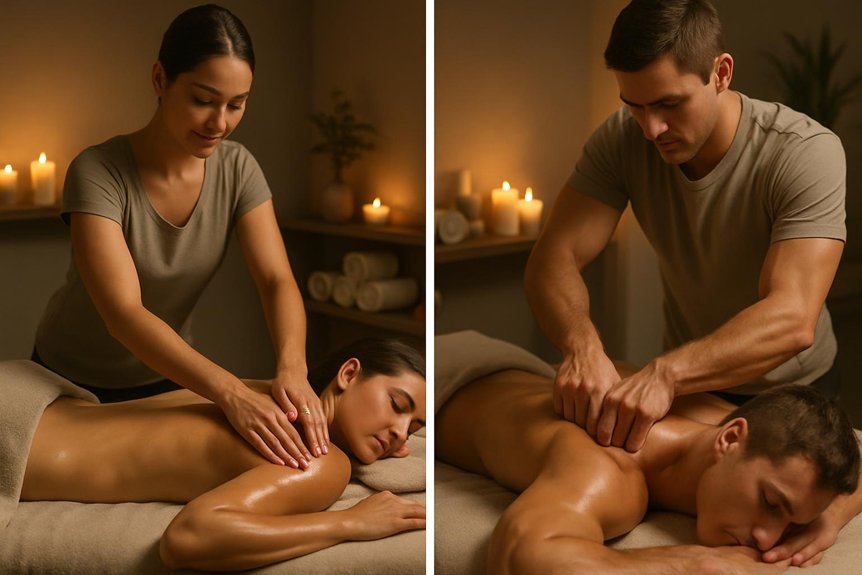
How do Swedish and deep muscle therapy differ in their fundamental techniques? Swedish massage employs long, gliding effleurage strokes, gentle kneading (petrissage), rhythmic tapping (tapotement), friction, and vibration to enhance circulation and induce relaxation. The technique is systematic, focusing on superficial muscle layers and using lubricant oils to facilitate fluid movement.
In contrast, therapeutic deep massage concentrates on targeted, deliberate strokes, primarily using the thumbs, knuckles, and elbows to access deeper musculature and connective tissues. Therapists at Spa & Massage are trained to distinguish and apply these techniques according to client needs.
Swedish massage emphasises broad, flowing motions for overall relaxation, while focused therapeutic techniques utilise slower, more concentrated movements to address specific muscular adhesions, contributing to a more restorative experience for clients seeking deeper connection.
For an enhanced sensory experience, some massage sessions also incorporate the use of aromatherapy massage, which can help promote further relaxation and healing.
Pressure and Intensity: What Sets Them Apart
Swedish and therapeutic deep massage are distinguished by the degree of pressure applied, the depth of massage strokes, and the specific muscle groups addressed.
At Spa & Massage clinics, therapists adjust intensity to align with individual comfort levels and clinical objectives, ensuring a balance between therapeutic benefit and relaxation.
This targeted, evidence-based approach allows for both gentle, superficial techniques and more intense, focused work on deeper musculature.
Depth of Massage Strokes
While both Swedish and therapeutic deep massage employ manual manipulation of soft tissues, the depth and pressure of their strokes distinctly differentiate the two modalities.
Swedish massage typically utilises long, gliding effleurage and gentle kneading techniques that focus primarily on superficial muscle layers. This approach promotes relaxation and enhances circulation without penetrating deeply into the muscular tissue.
Conversely, this massage is characterised by slower, more deliberate strokes with increased pressure, targeting the deeper fascia and underlying muscle groups.
At Spa & Massage, therapists are trained to adjust the depth according to client preference and tissue response, ensuring both comfort and effectiveness. This careful modulation of stroke depth allows clients to experience either soothing surface contact or transformative release of entrenched muscular tension, depending on their needs.
Targeted Muscle Focus
Beyond differences in stroke depth, the specific muscle groups targeted and the intensity applied further distinguish Swedish from therapeutic deep massage. Swedish massage primarily addresses superficial musculature, employing broad, gentle strokes to encourage overall relaxation and improved circulation.
In contrast, therapeutic deep massage targets underlying muscle layers and connective tissues, focusing on chronic tension points and myofascial restrictions. At Spa & Massage, therapists utilise advanced palpation techniques to identify areas of muscular adhesions or persistent tightness, applying precise, sustained pressure during deep tissue sessions.
This focused approach is especially beneficial for clients experiencing limited mobility or postural imbalances. By differentiating the targeted muscular focus and adjusting pressure accordingly, each modality is tailored to meet individual needs, fostering a sense of deep physical connection and personalised therapeutic benefit.
Comfort and Adaptation
How do pressure and intensity shape the massage experience? At Spa & Massage clinics, these elements distinguish Swedish from deep tissue modalities.
Swedish massage utilises gentle to moderate pressure, prioritising relaxation and heightened sensory comfort. Techniques such as effleurage and petrissage are applied with fluidity, fostering a nurturing environment ideal for clients seeking stress reduction and emotional intimacy.
In contrast, this massage employs sustained, targeted pressure to address chronic muscular tension and adhesions.
Therapists at Spa & Massage adapt intensity based on client feedback, ensuring each session remains within personal comfort thresholds. This adaptive approach allows for a tailored experience—balancing therapeutic benefit with a sense of trust and safety.
Ultimately, pressure and intensity are carefully calibrated to each client’s needs and preferences.
Common Benefits of Swedish Massage
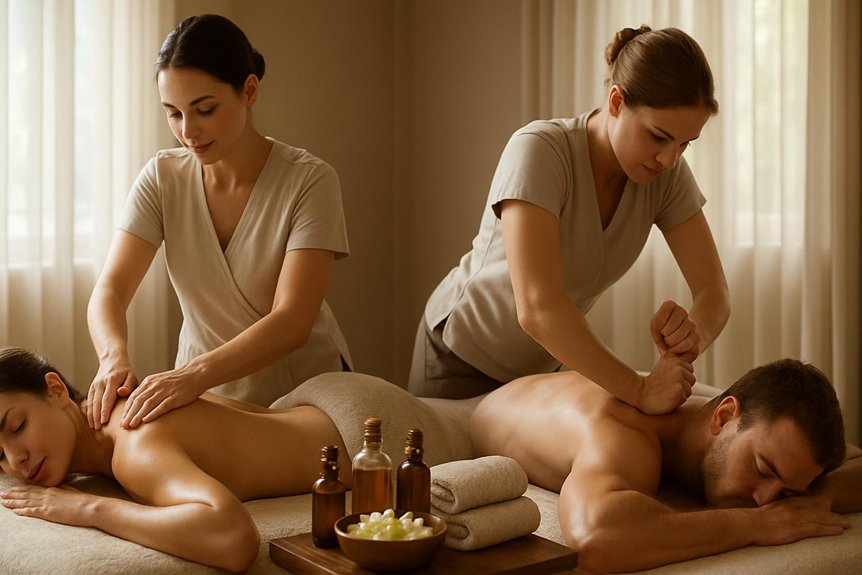
Swedish massage is widely recognized for its efficacy in promoting physiological relaxation and reducing stress-related symptoms through systematic, rhythmic techniques. Evidence indicates that this modality can enhance peripheral circulation and support improved joint flexibility, contributing to overall physical well-being.
At Spa & Massage, therapists employ these methods to facilitate both neuromuscular relaxation and increased tissue oxygenation for clients.
Promotes Relaxation and Calm
Frequently cited in clinical literature, the ability of this massage technique to promote relaxation and induce a state of calm is attributed to its systematic use of long, gliding strokes, kneading, and circular movements on superficial muscle layers. These methods stimulate the parasympathetic nervous system, fostering a reduction in heart rate and blood pressure, and facilitating the release of endorphins and serotonin.
At Spa & Massage, therapists employ gentle, rhythmic motions paired with carefully selected oils to create an environment conducive to deep tranquility. This sensory engagement not only alleviates muscular tension but also addresses psychological stress, encouraging a profound sense of comfort and emotional ease.
Clients frequently report enhanced mental clarity and an intimate feeling of serenity that extends well beyond the session.
Enhances Circulation and Flexibility
By employing a sequence of targeted effleurage and petrissage techniques, this form of massage stimulates peripheral blood flow, thereby improving oxygen and nutrient delivery to soft tissues.
Enhanced circulation not only supports cellular repair but also facilitates the efficient removal of metabolic waste products, contributing to overall tissue vitality.
In the context of flexibility, the gentle manipulation of muscle fibers encourages elongation and relaxation, reducing myofascial restrictions and joint stiffness.
At Spa & Massage, therapists carefully adapt each session to the client’s anatomical needs, focusing on areas prone to tension or reduced mobility.
This approach fosters greater range of motion and suppleness, which are essential for those seeking sustained intimacy and physical ease.
Regular sessions can yield cumulative improvements in both flexibility and circulatory health.
Key Advantages of This Massage
Among the primary therapeutic modalities offered at Spa & Massage, therapeutic deep massage delivers significant physiological advantages for individuals seeking targeted muscular relief. This technique employs slow, sustained pressure to penetrate the deeper layers of muscle and fascia, effectively addressing chronic tension and adhesions.
Evidence indicates that deep muscle therapy is particularly effective in alleviating musculoskeletal pain, improving postural alignment, and restoring range of motion. Many clients appreciate the profound sense of release and relaxation that follows, as our therapists methodically dissolve stubborn knots and tension.
Enhanced blood flow and lymphatic drainage further support tissue recovery and reduce inflammation. At Spa & Massage, therapists tailor every session to individual needs, fostering a personalised experience that nurtures both physical health and an intimate sense of well-being.
Ideal Clients for Each Massage Style
A clear distinction exists between individuals who benefit most from Swedish massage and those for whom deep muscle therapy is ideal.
Swedish massage is particularly suited for clients seeking relaxation, stress reduction, and gentle tension relief, often recommended for those new to massage or preferring lighter touch. At Spa & Massage clinics, this approach is tailored for individuals experiencing emotional or mental fatigue, aiming to foster a sense of calm and holistic wellbeing.
In contrast, therapeutic deep massage is designed for clients with chronic muscular discomfort, postural imbalance, or persistent knots—often athletes or those with physically demanding routines. Our therapists apply advanced techniques to address deeper layers of muscle tissue, making this modality preferable for targeted pain management and recovery.
Each style serves distinct therapeutic intentions, aligning with specific client profiles.
Typical Session Experience at Spa & Massage
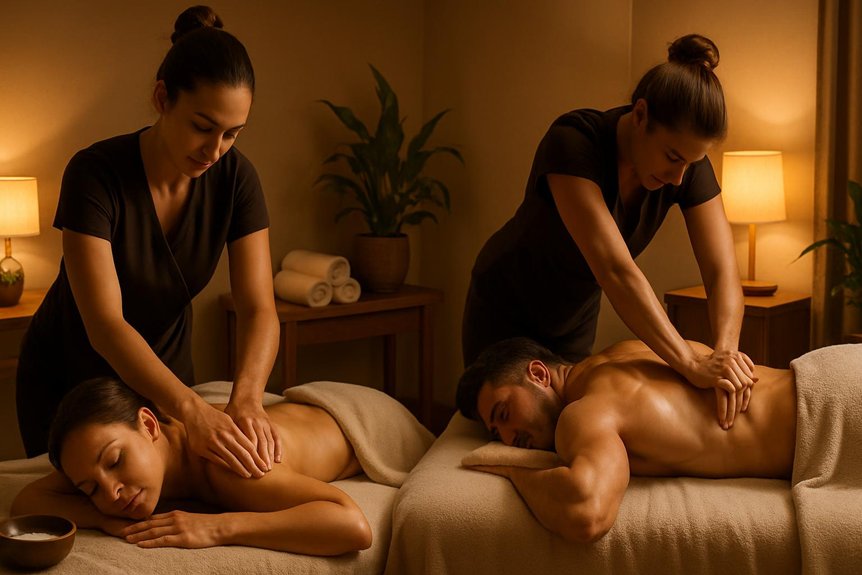
Upon arrival at Spa & Massage clinics, clients are welcomed into a tranquil environment purposefully designed to promote relaxation and comfort. Each session begins with a confidential consultation to assess musculoskeletal health, tension points, and personal preferences.
Experienced therapists employ clinical reasoning to tailor techniques—whether Swedish or deep tissue—ensuring targeted efficacy. Unscented or aromatherapy oils, selected based on client sensitivities and therapeutic goals, facilitate ideal glide and skin nourishment.
The treatment room’s ambient lighting and calming acoustics foster deeper relaxation and a sense of safety. Therapists maintain clear, professional communication throughout the session, adjusting pressure and technique as needed for client comfort.
After the massage, guidance is provided regarding hydration, postural care, and individualized aftercare to extend therapeutic benefits beyond the clinic.
Choosing the Right Massage for Your Needs
How does one determine the most suitable massage modality for specific therapeutic outcomes? The decision hinges on a thorough assessment of musculoskeletal complaints, stress levels, and wellness objectives.
Swedish massage, characterized by gentle effleurage and petrissage, is ideal for individuals seeking relaxation, improved circulation, and reduced emotional tension.
This massage, utilizing slow, targeted pressure, addresses chronic muscle adhesions and restricted mobility.
At Spa & Massage clinics, therapists conduct a comprehensive consultation to identify client goals, medical history, and any contraindications.
By integrating evidence-based techniques with client preferences, the optimal treatment plan is established.
Ultimately, the choice between Swedish and deep muscle therapy depends on individual needs—whether prioritizing soothing comfort or therapeutic intensity—ensuring every session delivers both physical relief and a sense of intimate well-being.
Aftercare Tips From Our Therapists
Following the selection of an appropriate massage modality, post-treatment care substantially influences therapeutic outcomes and client well-being. At Spa & Massage, therapists recommend immediate rehydration post-session to facilitate metabolic waste elimination. Gentle stretching prolongs myofascial relaxation, while avoiding strenuous activity allows neuromuscular adaptation.
Application of a warm compress can enhance vasodilation and reduce residual muscle tension. For clients experiencing post-deep tissue soreness, therapists advise alternating heat and cold therapy as needed. Restful sleep remains essential; adequate rest supports tissue repair and parasympathetic activation.
In-clinic, therapists guide clients in recognizing post-massage sensations and adjusting self-care routines accordingly. Regular sessions, tailored advice, and open communication with therapists optimize the cumulative benefits of massage and empower clients to integrate therapeutic touch into their holistic wellness journey.
Conclusion
Ultimately, discerning the nuanced distinctions between Swedish and therapeutic deep massage empowers clients to make informed decisions aligned with their therapeutic goals. Whether seeking relaxation through gentle, flowing strokes or requiring targeted intervention for chronic muscular tension, the most suitable modality depends on individual needs and clinical indications. Is it not prudent, then, to consult with a qualified therapist to determine which evidence-based approach will best promote musculoskeletal health and overall wellbeing within a professional spa environment?
